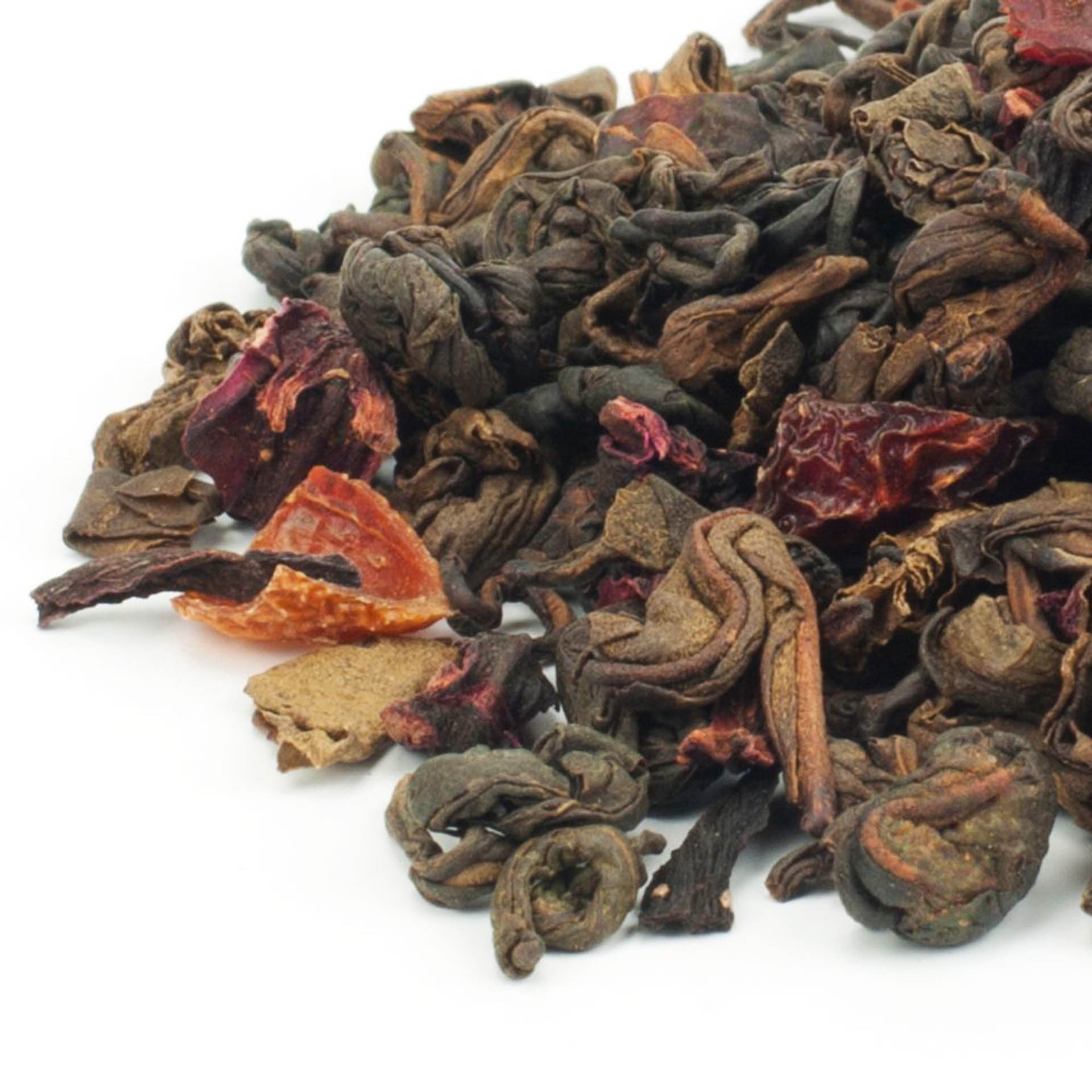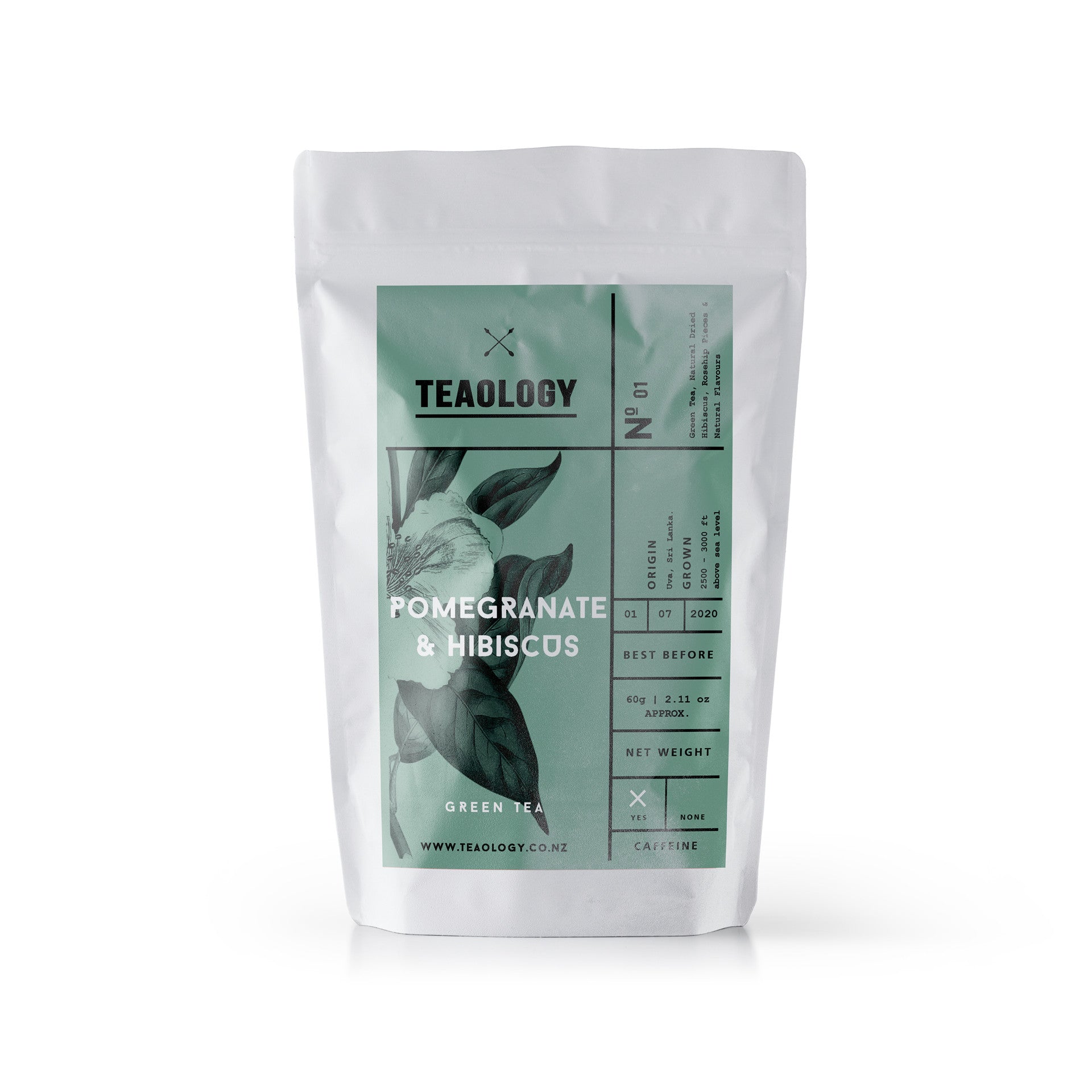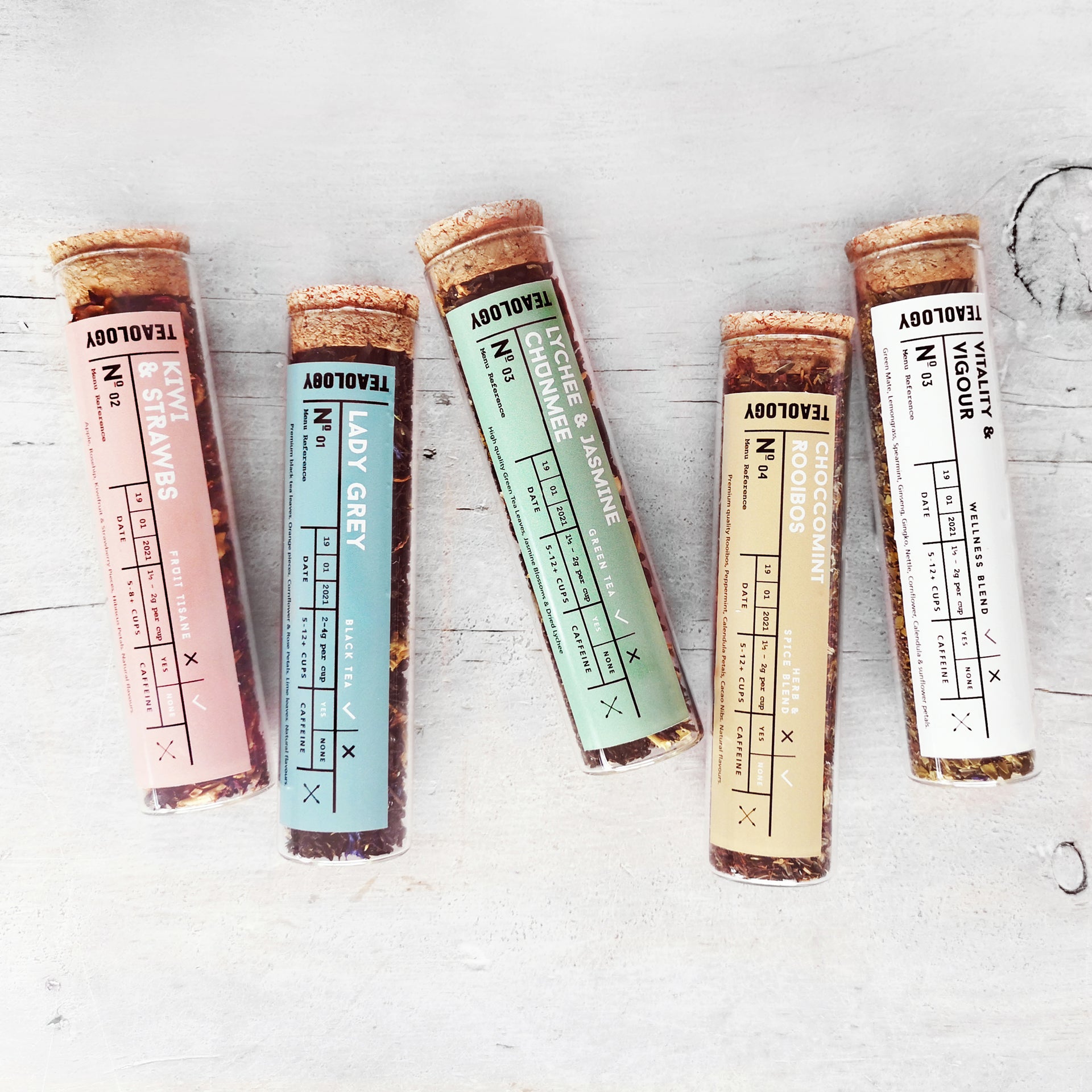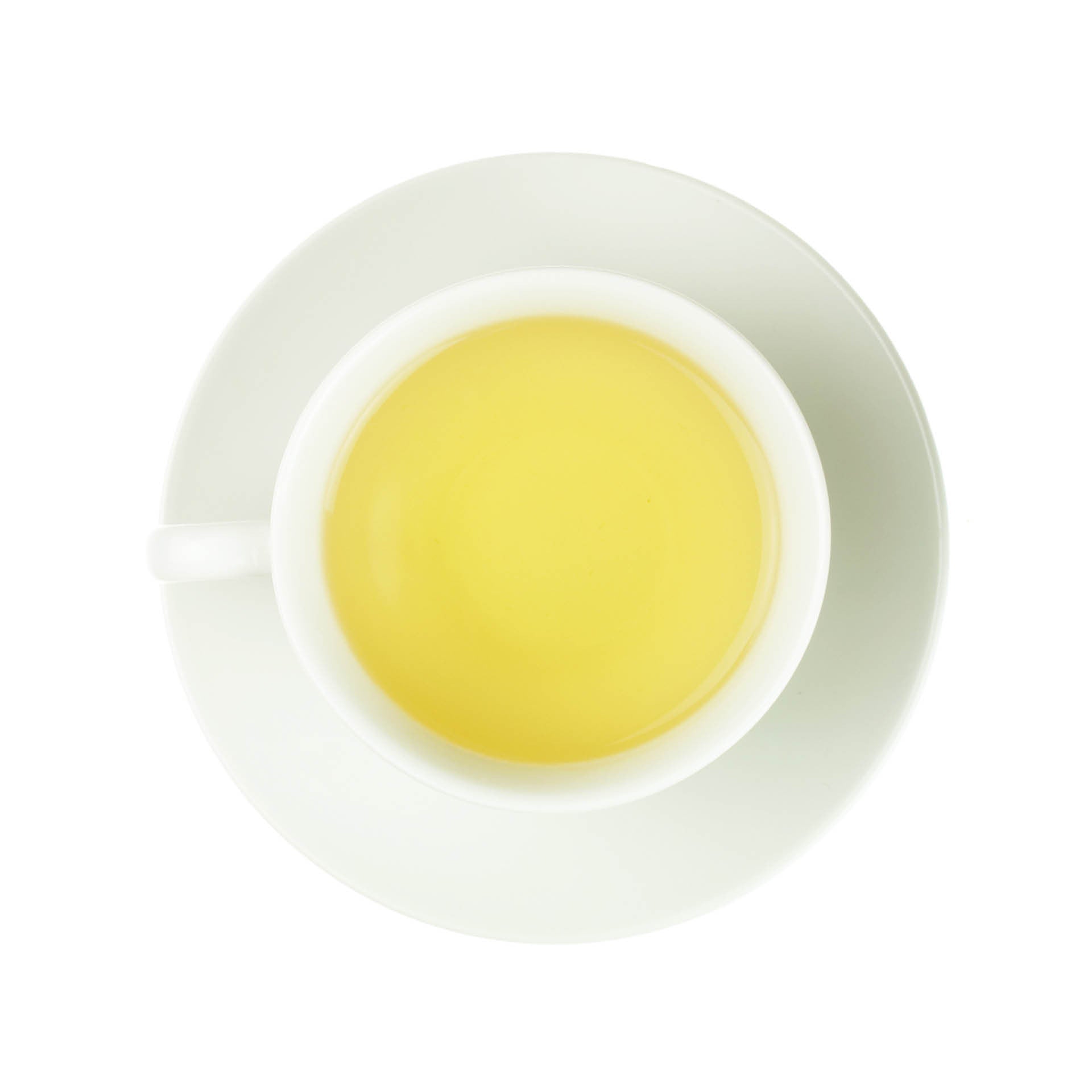Pomegranate & Hibiscus
By Teaology
Pomegranate and Hibiscus gunpowder green tea offers a really interesting cup. The combination of the gunpowder leaf and naturally dried hibiscus and rosehip produces a slightly tart, yet sweet berry astringency complemented by the hint of grassy notes.
BREWING RECOMMENDATION
1-2 teaspoons per cup
INGREDIENTS
High-quality gun powder green tea, Hibiscus, Rosehip Pieces, Natural Flavours
ORIGIN
Uva, Sri Lanka.
ALTITUDE
2500 - 3000ft above sea level
BAG 60g NET
Makes 15 - 30 standard cups of tea depending on personal strength of brew
TEA-SER VIAL
Makes 5 - 10 standard cups of tea depending on personal strength of brew
Health Benefits
-
Antioxidants in Tea
Antioxidants are chemicals that naturally help fight the harmful oxidation effects of unstable molecules in your body called free radicals that occurs naturally in the body when you are exposed to harmful environmental factors. Free radicals have extra electrons around them that bombard the molecules of cell membranes which leads to cell damage. Antioxidants take up these extra electrons so that your cells don’t have to. Free radicals may come from environmental contaminants such as radiation, pollution and exposure to toxins; but they also form as a result of normal bodily processes such as breathing oxygen.
There are three primary types of antioxidants found in nature. These include phytochemicals, vitamins, and enzymes. Although black tea has high levels of some essential antioxidant enzymes and vitamins such as Magnesium and Folate is it the Phytochemicals in tea that make them so powerful.
Antioxidant Phytochemicals
Phytochemicals are the antioxidants that are naturally used by plants to protect themselves against free radicals . Studies show that humans who eat sources of phytochemicals also benefit from the antioxidant properties of the plant. Phytochemicals are broken down into the following categories:• Carotenoids
• Flavonoids
• Allyl sulfides
• PolyphenolsMain flavonoids of a living tea leaf
Flavonoids are secondary metabolites (a group of naturally occurring biochemicals) that help a plant to grow strong and attain its various biological characters, such as its smell, colour or self-defense. The amount and varieties differ in different plants and in different parts and growing stages of a plant. The most predominant flavonoids in a growing young tea leaf are:Catechins in tea
• Catechin, Epigallocatechin (EGC)
• Epigallocatechin 3-gallate (EGCG)
• Epicatechin (EC)
• Epicatechin 3-gallate (ECg, or ECG, or EC3G)Catechins protect cell DNA. They are anti-mutagenic, anti-inflammatory and anti-pathogenic all delivered in a cup of tea.
Of all the catechins, EGCG, is a unique catechin in tea, has repeatedly demonstrated itself as the most potent health contributive factor in tea. It accounts for 50~75% of the catechins in green teas.Once a tea leaf is plucked, its flavonoids very slowly undergo a process of enzyme triggered oxidation that cause them, in particular the catechins, to transform into various substances, some are other forms of flavonoids, some yet other substances that may influence the taste and aroma of the final product. The production of various categories of tea is largely based on the control of this oxidation phenomenon. This oxidation of catechins is called “fermentation” in the tea production process.
Flavonols in tea
• Kaempferol
• Myricetin
• QuercetinKaempferol:
Acts as an antioxidant by reducing oxidative stress. Anti-inflammatory, antimicrobial, anticancer, cardioprotective, neuroprotective, antidiabetic, antiosteoporotic, estrogenic/antiestrogenic, anxiolytic, analgesic, and antiallergic activities. It has been linked with many sucessful anti-cancer treatments and and it is currently under consideration as a possible cancer treatment.Myricetin:
Myricetin works by disrupting cellular pathways. It interacts with enzymes and suppresses their activities (enzyme inhibition). Myricetin, is an anti-inflammatory, prevents blood clots, has many anti-cancer properties, increases glucose uptake thus helping manage diabetes, slows the progression of Alzheimers disease, protects the heart, controls fat deposition and helps prevent weight gain, anti-microbial, helps protect the skin against UV radiation and prevents skin wrinkles, protects eyesight and increases bone mass, Myricetin also increases iodine uptake as well as iodine retention by thyroid cells.Quercetin:
Inflammation is the root of most diseases, and Quercetin effectively fights anti-inflammatory related diseases such as: Atherosclerosis, circulation, high cholesterol, insulin resistance and diabetes, heart disease, eye-related disorders including cataracts, allergies, asthma and hayfever, stomach ulcers, cognitive impairment, gout, viral infections, inflammation of the prostrate, bladder and ovaries, chronic fatigue syndrome, cancer, chronic infections of the prostrate and skin disordersFlavones in tea
• Apigenin
• LuteolinApigenin:
Anti-inflammatory, antidepressant-like effects, anti-cancer properties, protects the heart, prevents bone loss, stimulates brain cell generation.Luteolin:
Luteolin interferes with nearly all types of cancer cells.
It inhibits the growth of new blood vessels in tumors, the metabolism of carcinogens, as well as stopping the progression of the cell cycle in cancer cells. Luteolin also induces cell death in cancer cells. Luteolin is also an anti-inflammatory, antioxidant, prevents UVB-induced skin aging, luteolin can be used in the prevention and treatment of cardiovascular diseases, protects the brain from neurological impairments, anti-viral properties, helps prevent cataracts, Luteolin has anti-oxidant and anti-inflammatory effects which can reduce the effects of multiple sclerosis, Luteolin has anti-oxidant and anti-inflammatory effects which can reduce the effects of multiple sclerosisFlavonoids in green tea
In the case of a fine green tea, the plucked leaf is withered very briefly for slight dehydration and then put through heat to halt the enzyme-triggered oxidation. The most original and quantity of flavonoids are thus kept. They can take up an average of 30% of the dry weight of the tea, dependent on the tea variety, pluck quality and harvest season. That means you have on average 300 mg of catechins and other flavonoids in each gram of tea leaves.Flavonoids in black tea
When the fresh leaves are taken to produce black tea, a large proportion of these flavonoids and catechins is oxidized to become other substances, mostly flavonoids of larger molecular structures, such as:• Theaflavins (TF)
• Thearubigins (TR)
• Theabrownins (TB)While most of medical researches on tea’s health potential focus around green tea catechins, in particular EGCG, there are a number done on theaflavins, finding that they may also be contributive to reduction of cardiovascular diseases and prevention of diabetes. Theaflavins contribute to the yellowish orange colour of the black tea infusion. They make up on average 6% of the black tea flavonoids.
Much fewer studies have been done on theabrownins, which are a lot more abundant in post-fermented teas, but with promising results on cholesterol control resulting in a reduced risk for heart disease. The antioxidants in green, black, and oolong teas can help block the oxidation of LDL (bad) cholesterol, increase HDL (good) cholesterol and improve artery function.
Drinking a cup of tea a few times a day helps to absorb antioxidants and other nutritional plant compounds. In green-tea drinking cultures, the usual amount is three cups per day. Allow tea to steep for three to five minutes to bring out its catechins. The best way to get the catechins and other flavonoids in tea is to drink it freshly picked and freshly brewed. Decaffeinated, bottled ready-to-drink tea (bag) preparations, and instant teas have less of these compounds.
Note that tea can impede the absorption of iron from fruits and vegetables. Adding lemon or milk or drinking tea between meals will counteract this problem.
-
Green Tea
Weight Loss
Green/white tea increases the metabolism. The polyphenol found in green/white tea works to intensify levels of fat oxidation and the rate at which your body turns food into calories.Diabetes
Green/white tea helps regulate glucose levels by slowing the rise of blood sugar after eating. This can prevent high insulin spikes and resulting fat storage.Heart Disease
Scientists think green/white tea works on the lining of blood vessels, helping keep them stay relaxed and better able to withstand changes in blood pressure. It may also protect against the formation of clots, which are the primary cause of heart attacks.Esophageal Cancer
It can reduce the risk of oesophagal cancer, but it is also widely thought to kill cancer cells in general without damaging the healthy tissue around them.Cholesterol
Green/white tea reduces bad cholesterol in the blood and improves the ratio of good cholesterol to bad cholesterol.Alzheimer’s and Parkinson’s
Current research sugggests that drinking Green/White tea delays the deterioration caused by Alzheimer’s and Parkinson’s disease. Studies carried out on mice showed that green/white tea protected brain cells from dying and restored damaged brain cells.Tooth Decay
Studies suggest that the chemical antioxidant 'catechin' in tea can destroy bacteria and viruses that cause throat infections, dental cavities and other dental conditions.Blood Pressure
Regular consumption of green/white tea is thought to reduce the risk of high blood pressure.Depression
Theanine is an amino acid naturally found in tea leaves. It is this substance that is thought to provide a relaxing and tranquillizing effect and be a great benefit to tea drinkers.Anti-viral and Anti-bacterial
Tea catechins are strong antibacterial and antiviral agents which make them effective for treating everything from influenza to cancer. In some studies, green/white tea has been shown to inhibit the spread of many diseases.Skincare
Green and white tea also helps with wrinkles and premature ageing, This is because of the high levels of antioxidant and anti-inflammatory activities. Both animal and human studies have demonstrated that green tea applied topically can also reduce sun damage. -
Hibiscus Flowers
Not many people are aware that almost 15–30% of hibiscus tea is composed of organic acids. These acids are malic acid, tartaric acid and citric acid. These acids are commonly found in many fruits such as grapes and wine. They help in boosting immunity, promoting better skin, lowering blood pressure and cholesterol and managing inflammation. Hibiscus tea has diuretic and choleretic effects, thus controlling blood viscosity by reducing blood pressure and enhancing digestion. Hibiscus contains flavonoids and anthocyanins, which have antioxidant properties and have been shown to support heart health. Hibiscus tea has also been used traditionally to treat coughing and poor appetite, and it has been used for its antibacterial and antifungal properties. In addition, drinking hibiscus tea may help with digestive orders, such as an upset stomach, as it can help relax the smooth muscle of the intestine.
Weight Loss
Hibiscus tea is also beneficial for losing weight. If you consume food that is rich in carbohydrates, that means that it contains sugar and starch, so you are likely to gain weight. However, research studies have suggested that hibiscus extract lowers the absorption of starch and glucose and may help with weight loss. Hibiscus inhibits the production of amylase, which helps in the absorption of carbohydrates and starch, so drinking hibiscus tea prevents that absorption from occurring. Therefore, hibiscus tea is found in many weight loss products.Aids Digestion
Many people drink hibiscus tea to improve digestion. It increases both urination and bowel movements. Since it has diuretic properties, it is also used to treat constipation, which helps you lose weight and improve the health of your gastrointestinal system and avoid colorectal cancer.Satiates Thirst
Hibiscus tea is also used in the same way as sports drinks in order to satiate thirst. For this purpose, an iced form of hibiscus tea is typically consumed. Many people include it in their diet since this variety of the tea has the ability to cool down the body very fast. Also, it is rich in medicinal properties, like being a diuretic, which flushes out excess fluids and toxins from the body and guarantees that you will perform at your best!Blood Pressure
Management Consuming hibiscus tea lowers the blood pressure in pre-hypertensive and mildly hypertensive adults. As it has anti-hypertensive and cardio-protective properties Hibiscus buds can be beneficial to people suffering from hypertension and those at high risks of various cardiovascular diseases. A recent study discovered hibiscus tea to be more effective than hydrochlorothiazide, a common blood-pressure lowering medication, at decreasing blood pressure. The most significant finding was that hibiscus tea, unlike its study counterpart, hydrochlorothiazide, did not cause electrolyte imbalance.
Anti-inflammatory Because of its anti-inflammatory properties, hibiscus tea can reduce blood pressure by up to 10 points. For this drastic improvement to occur, you need to consume three cups every day for a few weeks. Also, hibiscus tea has diuretic properties that increase urination, simultaneously lowering blood pressure.Lowering Cholesterol
Hibiscus tea also has impressive antioxidant properties. It helps to lower levels of bad LDL cholesterol from the body, thereby helping to protect against heart disease and protecting blood vessels from damage. The hypolipidemic and hypoglycemic properties of hibiscus tea can be beneficial for those who suffer from blood sugar disorders like diabetes. A research study conducted on patients with type II diabetes suggests that consumption of hibiscus tea lowers cholesterol, triglycerides and low density lipo-protein cholesterol, which helps to manage this unpredictable disease.Protects Liver
Research studies have also suggested that the antioxidant properties of hibiscus tea may also help in treating liver disease. Antioxidants help to protect your body from diseases because they neutralize the free radicals present in body tissues and cells. Therefore, we can confidently say that drinking hibiscus tea could increase your lifespan by maintaining good overall health in many organ systems.Anti-Cancer Properties
Hibiscus tea contains hibiscus protocatechuic acid which has anti-tumor and antioxidant properties. A study conducted by the Department and Institute of Biochemistry at the Chung Shan Medical and Dental College, in Taichung, Taiwan suggests that hibiscus slows down the growth of cancerous cells by inducing apoptosis, commonly known as programmed cell death.Anti-Inflammatory and Antibacterial Properties
Hibiscus tea is rich in ascorbic acid, also known as vitamin C. It is an essential nutrient required by your body to boost and stimulate the activity of your immune system. Hibiscus tea is also known for its anti-inflammatory and antibacterial properties. Therefore, it prevents you from catching the cold and flu. Hibiscus tea is also used to treat discomfort caused by fever, due to its cooling effect.Menstrual Pain
The health benefits of hibiscus tea also include relief from cramps and menstrual pain. It helps in restoring hormone balance as well, which can reduce other symptoms of menstruation like mood swings, depression, and overeating.Antidepressant Properties
Hibiscus tea contains vitamins and minerals like flavonoids which have antidepressant properties. Consumption of hibiscus tea can help to calm down the nervous system, and it may reduce anxiety and depression by creating a relaxed sensation in the body and mind.HIBISCUS TEA SIDE EFFECTS
Although hibiscus tea is a health enhancer and a natural weight loss booster, there are some possible side effects you should be aware of.Blood Pressure
The health benefits of hibiscus tea include lowering blood pressure (anti-hypertensive property). Therefore, it is not recommended for people that already have low blood pressure, a condition called hypotension. It may cause faintness, dizziness and can even damage the heart or brain if it is consumed by an individual with low blood pressure.Pregnancy and Fertility
Hibiscus tea is not recommended for pregnant women, particularly due to its emmenagogue effects which may stimulate menstruation or blood flow in the uterus or pelvic region. For those undergoing hormonal treatments or taking birth control pills, it is recommended to consult your health specialist regarding any consumption of hibiscus tea, and let him give you a yes or no.Hallucinatory Effect
Some people may feel intoxicated or experience hallucination when drinking hibiscus tea. Therefore, you should be somewhat cautious until you know how your body react to the tea. Don’t drive a car or try anything particularly dangerous until you know what its effects are on your system.
AllergySome people might develop allergic reactions such as itchy red eyes, sinus, or hay fever when consuming hibiscus tea. -
Rosehip Buds
+ Helps prevent cancer and other chronic diseases
+ High in flavonoids and antioxidants
+ Anti-inflammatory
+ Reduces wrinkles and fine lines
+ Applied topically combats the UV damage by the sun
+ Essential fatty acids prevent scarring and encourages skin regeneration
+ Helps treat skin pigmentation
+ Contains vitamin A that improves moisture content of the skin
+ Contains quercetin which helps prevent Melanoma
+ Enhances blood circulation
+ Improves kidney function
+ Contains phenols, ascorbic acid, beta-carotene, tannins, and pectins
+ Flavanoids including tiliroside which suppresses inflammation
+ Carotenoids which decreases acceleration of some tumours
+ Contains lycopene
+ Lowers cholesterol
+ Contains 60 times the vitamin C than an orange
+ Promotes collagen production
+ Boosts immunity
+ Maintains blood vessel health
+ Helps with iron absorption
+ Contains the fatty acid GOPO (Plant version of fish oil)
+ Anti-arthritic properties
+ Lowers blood sugar levels
+ Regulates blood pressure
+ Reduces the risk of cardiovascular disease




